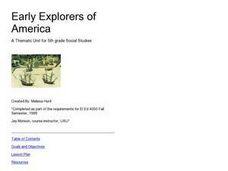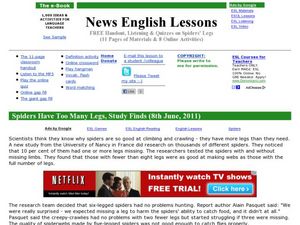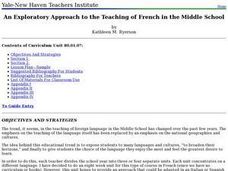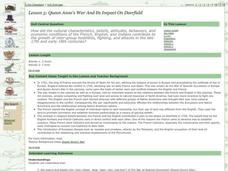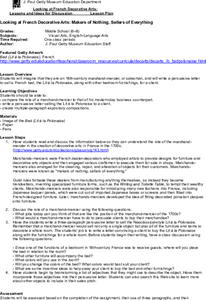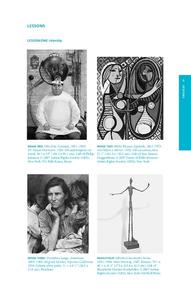Curated OER
Why Not Come to North Amercia?
Young scholars examine the motives for French expansion into the New World, they evaluate primary source documents to determine who, what, when, where and why.
Curated OER
Liberty, Equality, Uniformity?
Young scholars examine the French draft law to ban religious symbols from public schools. They research "secularist" and "pluralist" positions regarding this ban, debate the topic in class, and draft a position paper on the ban.
Curated OER
Japan, France to Develop Super-Concorde
In this ESL worksheet, students read the given article and its presented vocabulary throughout. Students respond to 51 short answer, matching, true/false, and fill in the blank questions.
Curated OER
Educator's Tools: Biodiesel Lesson
Students are able to determine whom Rudolf Diesel was. They discover that biodiesel is a renewable fuel. Students can define what renewable means. They get a clear usable defintion of what triglycerides are. Students get to see how...
Curated OER
Cooking Crepes in Ms. Stentella's French Class
Learners explore eating, cooking, and life in France and identify table-setting vocabulary and restaurant conversational skills. After reviewing the crepe recipe, students pair up and do a mini WebQuest on crepes and find cultural...
Curated OER
Early Explorers of America
Fifth graders examine a time line of early American explorers from England, Spain, and France. They trace exploration routes on maps and write reports about early explorers. Students view a laser disc presentation, Land of Opportunity...
Curated OER
Art and War
Students analyze art and war and the Futurist movement. In this art analysis lesson, students define manifesto and its role with artistic movement. Students explore art as a response to political and social issues through image based...
Curated OER
The Citizen in de Tocqueville's America
Students explore democratic values. In this government systems lesson, students listen to their instructor lecture on Democracy in America by de Tocqueville. Students respond to discussion questions connected to the lecture.
Curated OER
Spiders Have Too Many Legs, Study Finds
Students explore current events by answering study questions about an article. In this arachnids lesson, students read a recently published article which discusses the importance of spiders and their 8 legs. Students answer study...
Curated OER
An Exploratory Approach to the Teaching of French in the Middle School
Middle schoolers review the most recent vocabulary list of French words. Using literature by Victor Hugo and Guy de Maupassant, they discover the history and culture of France. Using a map and the text, they locate the cities and...
Curated OER
A "Clear and Present Danger"
Students define what is meant by clear and present danger. In this First Amendment instructional activity, students listen to their instructor present a lecture regarding the details of the Sedition Act of 1798. Students consider...
Curated OER
Queen Anne's War and Its Impact on Deerfield
Students researchhow Queen Ann's War of Europe affect Native Americans in New England. After reading excerpts from History of Deerfiel by George Sheldon and Nuthatch's Dilemma, a story about a Pocumtuck woman, students are prepared to...
Curated OER
Looking at French Decorative Arts
Students compare the role of a marchand-mercier to that of a modern-day business counterpart and write a persuasive letter. In this French art lesson, students discuss the role of the marchand-mercier in French design and role-play his...
Curated OER
Looking at French Decorative Arts: Makers of Nothing, Sellers of Everything
Students imagine they are a 'marchand-mercier' (or salesman) and write a persuasive letter to sell French items. In this art analysis lesson plan, students identify the role of a 'marchand-mercier' and write a three-paragraph letter to...
Curated OER
Constructing Things
Learners analyze the history and art in the Constructivism movement. In this art analysis lesson, students analyze and consider the material types in the art form. Learners complete image based discussion. Students work in groups using...
Curated OER
Portraiture
Students explore the conventions of portraiture and the technique of photo-montage. For this art analysis lesson, students define portraiture and analyze the pictured pieces of art. Students make a photo-montage portrait or caricature as...
Curated OER
Checkmate: What is the History of Chess?
Students create a timeline. In this history of chess lesson, students use the Internet to examine the chess history timeline. Students read books on the history of chess, answer questions and create a timeline using a...
Curated OER
Transforming Everyday Objects
Students analyze Pop artists and their art. In this art analysis lesson, students consider the choices and mediums Pop art artists Andy Warhol, Roy Lichtenstein, Claes Oldenburg, and Jasper Johns. Students make connections between...
Curated OER
The Oblate Sisters of Providence and Early African American Education in Baltimore
Eighth graders examine the educational system for free African-Americans in Baltimore in the early 19th century. In this American History lesson, 8th graders read a handout and answer focus questions. Students analyze...
Curated OER
The Trip of the Speedwell and the Mayflower
Fourth graders investigate the hardships Pilgrims faced on the Mayflower and Speedwell. In this Pilgrim lesson, 4th graders listen to an account of the Pilgrim's voyage from Plymouth, England to present day Massachusetts. Students sit in...
Curated OER
Food and Languages of the World
Students listen to the story "No Blue Food" in this lesson. They then discuss Allegra, the main character, and her hesitation to try new foods. They participate in a matching game in which they match cards to determine a fruit topping...
Curated OER
Munich: Peace in Our Time
Pupils examine the Munich Agreement. In this World War II lesson, students analyze the agreement made among Germany, the United Kingdom, France, and Italy. Pupils discuss the strengths and weaknesses of the agreement.
Curated OER
Popular Culture
Students analyze the period of Belle Epoque and the methods of art that signified popular culture. In this art analysis lesson, students consider the ways popular culture influenced art by analyzing the images and completing image based...
Curated OER
Identity
Students analyze identify in art. In this art analysis lesson, students discuss what identify means and discuss how Otto Dix, Pablo Picasso, Dorothea Lange, and Alberto Giacometti represent identities in portraiture. Students complete...







